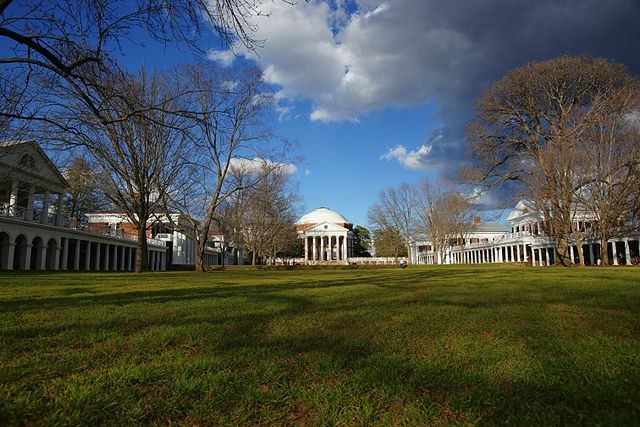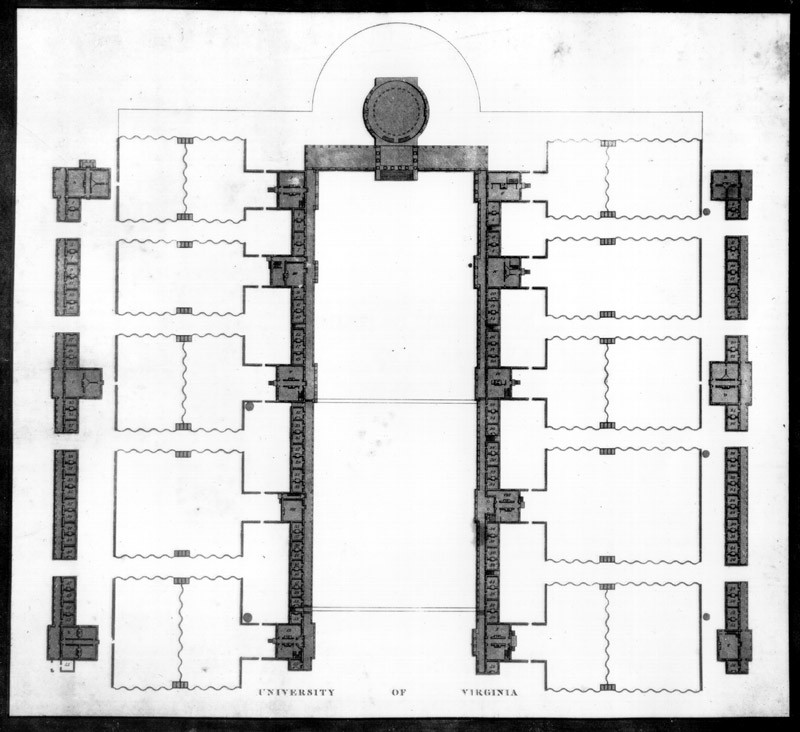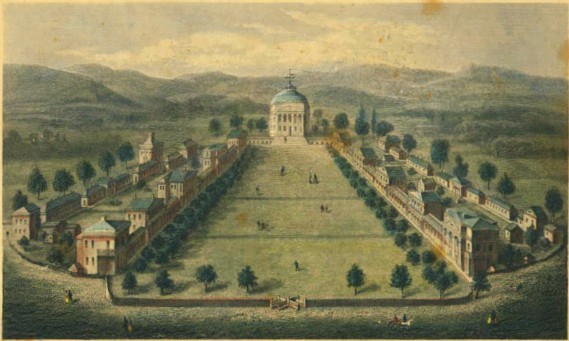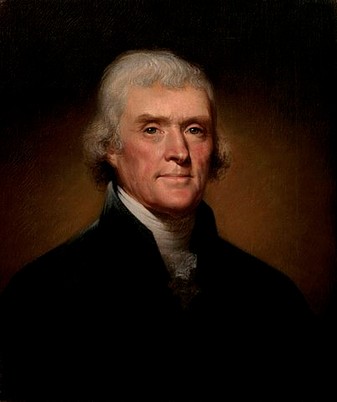The Lawn (U.Va)
Introduction
Text-to-speech Audio
The Lawn is a terraced, grassy court at the center of Thomas Jefferson's Academical Village. The term "Lawn" also can refer to the original grounds designed by Jefferson for U.Va. It consists of four rows of colonnades, student/faculty housing, and several larger buildings, such as the Rotunda. The Lawn is a designated U.S. National Historical Landmark District and included as part of the Monticello UNESCO World Heritage Site.
Images
The Lawn at U.Va, looking north

1826 Engraving by Peter Maverick of the plan of the University of Virginia, after Jefferson's drawing

1856 Engraving of the Lawn

Official Presidential Portrait of Thomas Jefferson

Backstory and Context
Text-to-speech Audio
The Lawn is located at the heart of the University of Virginia campus. This terraced, grassy field (35-acres in total) is a favorite spot for student recreational activities and is the site of numerous university ceremonies. These include opening ceremonies, fall convocation, and final exercises. The "Lighting of the Lawn" is an annual event that illuminates the Rotunda and marks the beginning of winter. As the central component of Thomas Jefferson's Academical Village, it is framed by student and faculty housing. The most famous building on the Lawn, the Rotunda, is located on the northern end. To the south is Old Cabell Hall, which was constructed later and does not follow Jefferson's original design.
Jefferson's vision for the Lawn was to provide an alternative to traditional English university quadrangle. He specified plans for a U-shaped model with a central dome, perhaps influenced by Joseph Jacques Ramée's design for Union College, Benjamin Latrobe's design for a military academy, the designs of Palladio, and his own residence at Monticello. The Lawn consists of four rows of colonnades on which alternate student rooms and larger structures. The inner rank of colonnades contains ten pavilions and 54 rooms for students. There are 206 columnns surrounding the lawn.
The ten pavilions of the lawn reflect Jefferson's classification of the branches of learning. Each features a distinctive design and, as a whole were intended to be a model for architectural study. Opposite the Pavillions and Lawn rooms are ten quiet gardens. The outermost row of buildings on either side, considered the edge of the Academical Village, are known as "the Range" and serve as graduate student housing. Garry Wills described the overall effect as "paradoxical," stating that the design alternated between "regimentation and individual expression," "hierarchical order," "relaxed improvising." However, "it is the reconciliation of these apparent irreconcilables that is the genius of the system."1
The rooms on the Lawn provided space for 216 student residents. Enrollment at the university, however, increased quickly. By 1861, students were seeking other university-approved accommodations. During the Second World War, the rooms were used as barracks for officer candidates. Today, living on the Lawn is considered a great honor. Meanwhile, the Pavillions were used as faculty housing and classrooms. Prior to the American Civil War, these pavilions housed professors, their families, and their slaves. Students were not permitted to bring their slaves on campus, but professors did, housing them in Pavillion or Hotel cellars or in outbuildings. One slave owned by the university, Lewis Commodore, lived in the Rotunda itself for two years.
The Rotunda is the most notable feature of the Lawn. In 1853, an Annex was added to the building, which provided classroom and meeting space. A fire gutted the Rotunda in 1895, destroying most of the university's library. Following the fire, the architect Stanford White (of McKim, Mead, and White) was hired to rebuild the structure. In addition, he created several new academic buildings at the base of the lawn to replace the Annex: Cocke Hall, Rouss Hall, and Cabell Hall. These buildings enclosed the southern view of the Blue Ridge Mountains and forced U.Va's subsequent architectural expansion to occur outside of the Academical Village.
Most recently, improvements to the Lawn have been accomplished as part of the "South Lawn Project." This effort generated controversy but was finally completed in 2010. By the end of the project, over 100,000 square feet of classroom and office space were added, as was a bridge over Jefferson Park Avenue. The Lawn is listed on the National Register of Historic Places (added 1970), the Virginia Landmarks Registry (added 1970), and is designated as a National Historical Landmark District (designated 1971). Along with the original buildings of U.Va and Monticello, the Lawn is also a contributing part of a UNESCO World Heritage Site.
Jefferson's vision for the Lawn was to provide an alternative to traditional English university quadrangle. He specified plans for a U-shaped model with a central dome, perhaps influenced by Joseph Jacques Ramée's design for Union College, Benjamin Latrobe's design for a military academy, the designs of Palladio, and his own residence at Monticello. The Lawn consists of four rows of colonnades on which alternate student rooms and larger structures. The inner rank of colonnades contains ten pavilions and 54 rooms for students. There are 206 columnns surrounding the lawn.
The ten pavilions of the lawn reflect Jefferson's classification of the branches of learning. Each features a distinctive design and, as a whole were intended to be a model for architectural study. Opposite the Pavillions and Lawn rooms are ten quiet gardens. The outermost row of buildings on either side, considered the edge of the Academical Village, are known as "the Range" and serve as graduate student housing. Garry Wills described the overall effect as "paradoxical," stating that the design alternated between "regimentation and individual expression," "hierarchical order," "relaxed improvising." However, "it is the reconciliation of these apparent irreconcilables that is the genius of the system."1
The rooms on the Lawn provided space for 216 student residents. Enrollment at the university, however, increased quickly. By 1861, students were seeking other university-approved accommodations. During the Second World War, the rooms were used as barracks for officer candidates. Today, living on the Lawn is considered a great honor. Meanwhile, the Pavillions were used as faculty housing and classrooms. Prior to the American Civil War, these pavilions housed professors, their families, and their slaves. Students were not permitted to bring their slaves on campus, but professors did, housing them in Pavillion or Hotel cellars or in outbuildings. One slave owned by the university, Lewis Commodore, lived in the Rotunda itself for two years.
The Rotunda is the most notable feature of the Lawn. In 1853, an Annex was added to the building, which provided classroom and meeting space. A fire gutted the Rotunda in 1895, destroying most of the university's library. Following the fire, the architect Stanford White (of McKim, Mead, and White) was hired to rebuild the structure. In addition, he created several new academic buildings at the base of the lawn to replace the Annex: Cocke Hall, Rouss Hall, and Cabell Hall. These buildings enclosed the southern view of the Blue Ridge Mountains and forced U.Va's subsequent architectural expansion to occur outside of the Academical Village.
Most recently, improvements to the Lawn have been accomplished as part of the "South Lawn Project." This effort generated controversy but was finally completed in 2010. By the end of the project, over 100,000 square feet of classroom and office space were added, as was a bridge over Jefferson Park Avenue. The Lawn is listed on the National Register of Historic Places (added 1970), the Virginia Landmarks Registry (added 1970), and is designated as a National Historical Landmark District (designated 1971). Along with the original buildings of U.Va and Monticello, the Lawn is also a contributing part of a UNESCO World Heritage Site.
Sources
1. "The Lawn." Wikipedia, the Free Encyclopedia. Accessed March 15, 2017. http://en.wikipedia.org/wiki/The_Lawn.
Barefoot, Coy. "According to Custom: Student Traditions at Virginia." UVA Magazine (Charlottesville), Fall 2007. Accessed March 15, 2017. http://uvamagazine.org/articles/according_to_custom/.
"The Lawn at the University of Virginia: Charlottesville, Virginia." American Planning Association. Accessed March 15, 2017. http://www.planning.org/greatplaces/spaces/2014/thelawn.htm.
The Lawn Looking North; image by Karen Blaha - Flickr: The lawn and rotunda, CC BY-SA 2.0, http://commons.wikimedia.org/w/index.php?curid=13275529.
Maverick Engraving; image by By Thomas Jefferson, Peter Maverick - http://repo.lib.Virginia.edu:18080/fedora/get/uva-lib:81674/uva-lib-bdef:100/viewCitation?style=, Public Domain, http://commons.wikimedia.org/w/index.php?curid=4744210.
1856 Engraving of the Lawn; image by J. Serz - University of Virginia Visual History Collection: mcgregor.lib.Virginia.edu cropped (frame, unreadable caption) & edited (color & contrast) by Ibn Battuta, Public Domain, http://commons.wikimedia.org/w/index.php?curid=1761919.
Official Presidential Portrait of Thomas Jefferson; image by Rembrandt Peale - http://www.whitehouseresearch.org/assetbank-whha/action/viewHome, Public Domain, http://commons.wikimedia.org/w/index.php?curid=20179140.
Barefoot, Coy. "According to Custom: Student Traditions at Virginia." UVA Magazine (Charlottesville), Fall 2007. Accessed March 15, 2017. http://uvamagazine.org/articles/according_to_custom/.
"The Lawn at the University of Virginia: Charlottesville, Virginia." American Planning Association. Accessed March 15, 2017. http://www.planning.org/greatplaces/spaces/2014/thelawn.htm.
The Lawn Looking North; image by Karen Blaha - Flickr: The lawn and rotunda, CC BY-SA 2.0, http://commons.wikimedia.org/w/index.php?curid=13275529.
Maverick Engraving; image by By Thomas Jefferson, Peter Maverick - http://repo.lib.Virginia.edu:18080/fedora/get/uva-lib:81674/uva-lib-bdef:100/viewCitation?style=, Public Domain, http://commons.wikimedia.org/w/index.php?curid=4744210.
1856 Engraving of the Lawn; image by J. Serz - University of Virginia Visual History Collection: mcgregor.lib.Virginia.edu cropped (frame, unreadable caption) & edited (color & contrast) by Ibn Battuta, Public Domain, http://commons.wikimedia.org/w/index.php?curid=1761919.
Official Presidential Portrait of Thomas Jefferson; image by Rembrandt Peale - http://www.whitehouseresearch.org/assetbank-whha/action/viewHome, Public Domain, http://commons.wikimedia.org/w/index.php?curid=20179140.
